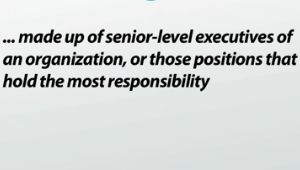Management in Organizations: Top, Middle & Low-Level Managers - Quiz
Choose your answer and write the correct one down. Then click HERE for the answers to this quiz.
NOTE: The transcript from the video is listed below the quiz for your reference.
1. Management consists of using which of the following to achieve organizational goals?
- Power
- People
- Resources
- People, Power, and Resouces
- People and Resources
2. This level of management works most closely with the greater workforce to ensure individual employees are meeting their performance goals.
- Low-level Management
- Middle-level Management
- Top-level Management
3. This level of management is responsible for developing and implementing strategic actions plans needed to achieve the organizational goals.
- Low-level Management
- Middle-level Management
- Top-level Management
4. Which of the three levels of management holds the greatest responsibility for the organization as a whole?
- Low-level Management
- Middle-level Management
- Top-level Management
The role of a manager in organizations is complex. While managers can come in different shapes and sizes they all share the task of utilizing people and resources to achieve organizational goals. This lesson will discuss the roles and functions of management found in each of the three levels of management.
Managers in the Workforce
In today's fast-paced, competitive world, businesses are continually changing. Most of these organizations are on the hunt for the competitive advantage, or a way to strategically move ahead of the competition in the marketplace. However, earning the competitive advantage takes work; goals must be set, plans must be made, people must be motivated and mobilized, resources have to be gathered and distributed, and objectives have to be monitored and assessed.
 |
Enter managers. These men and women come in many forms, but they all share the common task of working with people and resources to achieve organizational goals. An organizational goal can be something as simple as finding a way to shorten the amount of time it takes for a product to leave a warehouse or as elaborate as introducing a new product to the marketplace that makes all previous versions of this type of product obsolete. Regardless of the goal, someone needs to manage all of the factors necessary to seeing that goal become a reality.
Think of a manager as the foundation, support beams, and roof of a house. He or she provides the necessary support from the bottom up, and also provides oversight to all of the parts in between.
While this may seem like a great deal of responsibility and accountability for just one person to have, much like an onion, there are several layers of management. The roles and responsibilities a particular manager has correlates to their position in the organization. While job titles and roles can vary from organization to organization, they typically fall into one of three levels of management.
Top-Level Managers
The first level of management is called top-level management. Top management is made up of senior-level executives of an organization, or those positions that hold the most responsibility. Jobs titles such as Chief Operating Officer (COO), Chief Executive Officer (CEO), Chief Financial Officer (CFO), President, or Vice President are commonly used by top managers in organizations. These top managers are responsible for setting the overall direction of a company and making sure that major organizational objectives are achieved. Their leadership role can extend over the entire organization or for specific divisions such as finance, marketing, human resources, or operations.
 |
Middle-Level Management
The second layer of management is called middle-level management. This level of managers report to top management and serve as the head of major departments and their specialized units. Middle managers serve as a liaison between top managers and the rest of the organization from a very unique standpoint. They are typically much more visible to the greater workforce than top management, but they spend most of their time developing and implementing strategic actions plans needed to achieve the organizational goals set by top management.
Middle managers essentially have the important role of designing, selecting, and carrying out the best plan possible as a means of propelling a company towards its overall goals. Job titles of middle managers include directors, assistant directors, regional directors, division mangers, deans, branch managers, site managers, and so on.
 |
Low-Level Management
The third and final layer of management is called low-level management. Low-level managers work most closely with the greater workforce and hold a much more interpersonal role than any of the other levels of management. These managers work to ensure that individual employees are meeting their performance goals in a way that aligns with the organizational goals, such as completing a set number of projects by a specific deadline or selling a set number of products within a certain period of time. Titles of low-level managers can also vary significantly from company to company, but typically they resemble the department that they are situated in, such as accounting manager, academic affairs manager, human resources manager, head of financial operations, sales leader, and so on.
 |
Lesson Summary
Let's review.
Management is the use of people and resources to accomplish organizational objectives. Managers can come in many forms and serve a variety of functions. The roles and responsibilities of what a manager does can differ from organization to organization, but they are typically categorized into three levels: top-level management, middle-level management, and lower-level management.
Top-level management are your executives such as a CEO, CFO, President and Vice President. These top managers are responsible for setting the overall direction of a company and making sure that major organizational objectives are achieved.
Middle-level managers are the head of major departments and their specialized units; they hold titles such as director, assistant director, regional director, division manger, dean, branch manager, and site manager. They spend most of their time developing and implementing strategic action plans needed to achieve the organizational goals set by top management.
Low-level managers work most closely with the greater workforce to ensure that individual employees are meeting their performance goals in a way that aligns with the organizational goals.